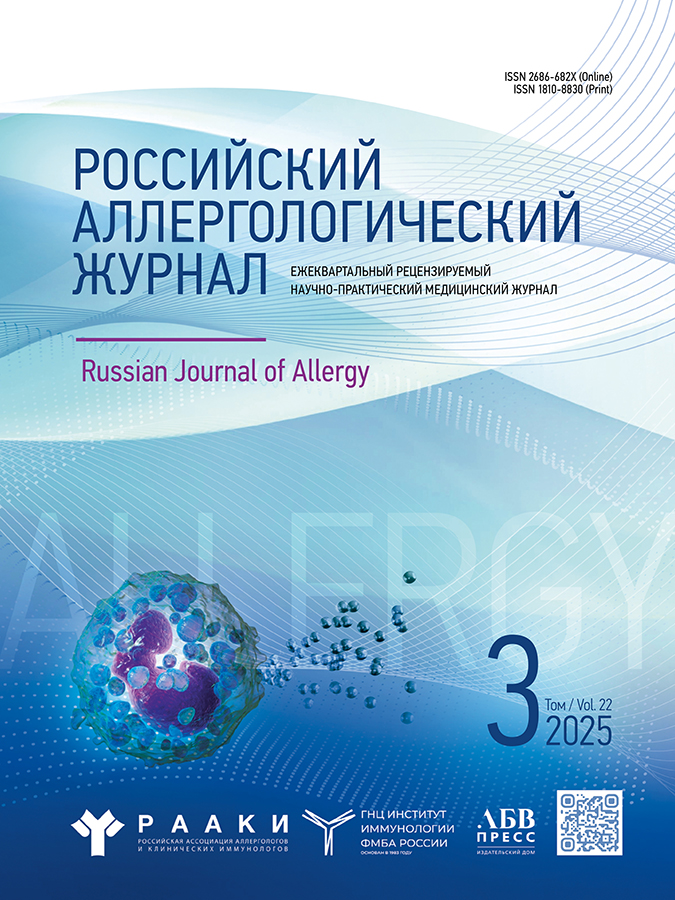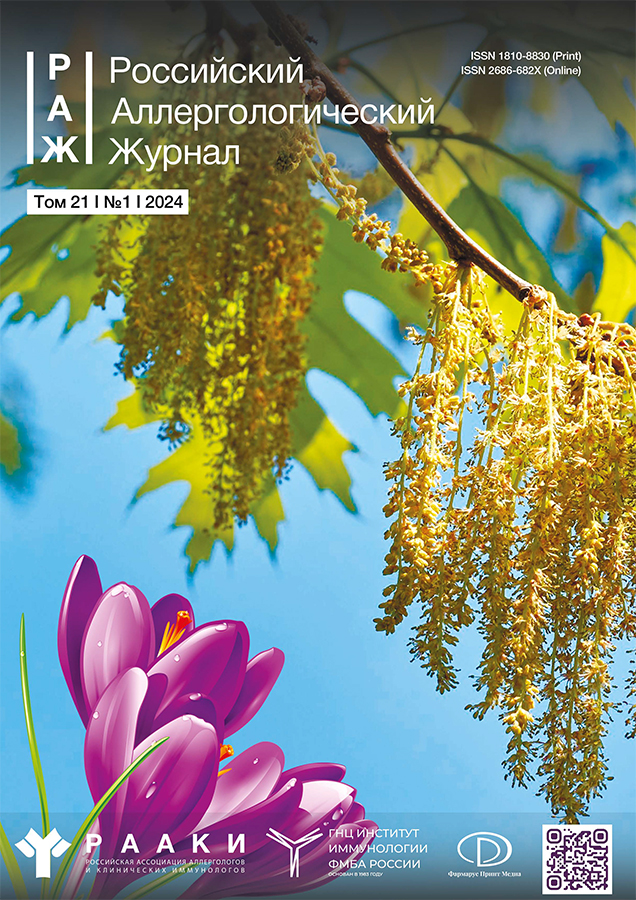Changes in the avids of IgG antibodies to the S protein of SARS-CoV-2 after coronavirus infection in medical workers of a temporary infections hospital
- Authors: Reshetnikova I.D.1,2, Tyurin Y.A.1,3, Agafonova E.V.1,3, Fassakhov R.S.2
-
Affiliations:
- Kazan Research Institute of Epidemiology and Microbiology
- Kazan Federal University
- Kazan State Medical University
- Issue: Vol 21, No 1 (2024)
- Pages: 43-54
- Section: Original studies
- Submitted: 18.10.2023
- Accepted: 06.03.2024
- Published: 15.04.2024
- URL: https://rusalljournal.ru/raj/article/view/16463
- DOI: https://doi.org/10.36691/RJA16463
- ID: 16463
Cite item
Abstract
BACKGROUND: The effector capabilities of humoral immunity are determined not only by the amount of specific antibodies produced in response to an antigenic effect, but also by their qualitative characteristics, which include avidity ― the total strength of binding to the antigen, which determines the duration and effectiveness of post-infectious immunity to SARS-CoV-2.
AIM: Is a selective study of the quantity and avidity of IgG antibodies to SARS-CoV-2 over time among medical workers of a temporary infectious diseases hospital in Kazan ― convalescents of COVID-19, during the period from July 2020 to July 2021.
MATERIALS AND METHODS: Determination of IgG to the S antigen of SARS-CoV-2 by ELISA was carried out using the test system SARS-CoV-2-IgG quantitative-ELISA-BEST (Vector-Best, Russia) and expressed in BAU/ml (binding antibody units). Antibody avidity was determined using a 4.0 M urea solution and expressed as avidity indices. 1, 4 and 7 months after COVID-19 asymptomatic (n=34); mild severity (n=42); moderate severity (n=29); reinfected (n=34). When statistically processing the data, descriptive statistics methods and the Wilcoxon matched data test were used. Differences were considered significant at p <0.05.
RESULTS: IgG avidity to SARS-CoV-2 depended on the severity of COVID-19. The highest rates of avidity indices were found in the group of those who had a moderate form of COVID-19. If in mild and asymptomatic forms there was a parallel decrease in avidity indices and IgG titer, then in moderate forms an increase in antibody titer was accompanied by a decrease in their avidity 4 months after the infection. 7 months after seroconversion, the IgG level decreased almost twofold, both in mild, asymptomatic and moderate forms. In the group of medical workers who had COVID-19 repeatedly, the initially low levels of avidity indices and antibody titers increased in parallel, while avidity indices after 7 months did not decrease, but remained high. Differences in avidity indices determined the subsequent formation of different trends in the development of the humoral immune response, which were mainly characterized by an uneven decrease in IgG and persistence of IgM antibodies for more than 1 month.
CONCLUSIONS: The research results expand the understanding of the mechanisms of formation of the humoral immune response and the avidity of IgG antibodies against SARS-CoV-2 in the risk group ― medical workers. The level of humoral immunity decreases in the first six months and varies depending on the severity of COVID-19. The data obtained can be used to identify categories of increased risk of SARS-CoV-2 infection among healthcare workers, make decisions about immunorehabilitation and revaccination against COVID-19.
Keywords
Full Text
About the authors
Irina D. Reshetnikova
Kazan Research Institute of Epidemiology and Microbiology; Kazan Federal University
Author for correspondence.
Email: reshira@mail.ru
ORCID iD: 0000-0002-3584-6861
MD, Cand. Sci. (Med.), Associate Professor
Россия, Kazan; KazanYuri A. Tyurin
Kazan Research Institute of Epidemiology and Microbiology; Kazan State Medical University
Email: tyurin.yurii@yandex.ru
ORCID iD: 0000-0002-2536-3604
MD, Dr. Sci. (Med.)
Россия, Kazan; KazanElena V. Agafonova
Kazan Research Institute of Epidemiology and Microbiology; Kazan State Medical University
Email: agafono@mail.ru
ORCID iD: 0000-0002-4411-8786
MD, Cand. Sci. (Med.)
Россия, Kazan; KazanRustem S. Fassakhov
Kazan Federal University
Email: farrus@mail.ru
ORCID iD: 0000-0001-9322-2689
MD, Dr. Sci. (Med.), Professor
Россия, KazanReferences
- Briko NI, Kagramanyan IN, Nikiforov VV, et al. Pandemic COVID-19. Prevention Measures in the Russian Federation. Epidemiology and Vaccinal Prevention. 2020;19(2):4–12. doi: 10.31631/2073-3046-2020-19-2-4-12
- Kudryashova AM, Manuylov VA, Murzina AA, et al. Dynamics in maturation of SARS-CoV-2 RBD-specific IgG antibody avidity depending on immunization timeframe and type. Russ J Infection Immunity. 2023;13(1):67–74. doi: 10.15789/2220-7619-DIM-2049
- Popova AYu, Ezhlova EB, Melnikova AA, et al. Herd immunity of SARS-CoV-2 among the population of Kalinigrad region amid the COVID-19 epidemic. J Infectology. 2020;12(5):62–71. doi: 10.22625/2072-6732-2020-12-5-62-71
- Bauer G. The potential significance of high avidity immunoglobulin G (IgG) for protective immunity towards SARS-CoV-2. Int J Infect Dis. 2021;106:61–64. doi: 10.1016/j.ijid.2021.01.061
- Underwood РA. Problems and pitfalls with measurement of antibody affinity using solid phase binding in the ELISA. J Immunol Methods. 1993;164(1):119–130. doi: 10.1016/0022-1759(93)90282-c
- Dauner J, Pan Y, Hildesheim A, et al. Development and application of a GuHCl-modified ELISA to measure the avidity of anti-HPV L1 VLP antibodies in vaccinated individuals. Mol Cell Probes. 2012;26(2):73–80. doi: 10.1016/j.mcp.2012.01.002
- Dimitrov J, Lacroix-Desmazes S, Kaveri V. Important parameters for evaluation of antibody avidity by immunosorbent assay. Anal Biochem. 2011;418(1):149–151. doi: 10.1016/j.ab.2011.07.007
- Benner SE, Patel EU, Laeyendecker O, et al. SARS-CoV-2 antibody avidity responses in COVID-19 patients and convalescent plasma donors. J Infect Dis. 2020;222(12):1974–1984. doi: 10.1093/infdis/jiaa581
- Tang J, Grubbs G, Lee Y, et al. Impact of convalescent plasma therapy on severe acute respiratory syndrome coronavirus 2 (SARS-CoV-2) antibody profile in coronavirus disease 2019 (COVID-19) patients. Clin Infect Dis. 2022;74(2):327–334. doi: 10.1093/cid/ciab317
- Interim guidelines "Prevention, diagnosis and treatment of new coronavirus infection (COVID-19)" Ministry of Health of the Russian Federation. Version 6. (28.04.2020). 2020. 165 р. (In Russ).
- Piccoli L, Park Y, Tortorici M, et al. Mapping neutralizing and immunodominant sites on the SARS-CoV-2 spike receptor-binding domain by structure-guided high-resolution serology. Cell. 2020;183(4):1024–1042.e21. doi: 10.1016/j.cell.2020.09.037
- Toptygina AP, Afridonova ZE, Zakirov RSh, Semikina EL. Maintaining immunological memory to the SARS-CoV-2 virus during COVID-19 pandemic. Russ J Infection Immunity. 2023;13(1):55–66. doi: 10.15789/2220-7619-MIM-2009
- Reshetnikova ID, Agafonova EV, Khakimov NM, et al. Features of the formation of seroprevalence to SARS-CoV2 in the population of the republic of tatarstan during the spread of COVID-19. Epidemiology and Vaccinal Prevention. 2023;22(1):13–21. doi: 10.31631/2073-3046-2023-22-1-13-21
- Lynch KL, Whitman JD, Lacanienta NP, et al. Magnitude and kinetics of anti-SARS-CoV-2 antibody responses and their relationship to disease severity. Clin Infect Dis. 2020;72(2):301–308. doi: 10.1093/cid/ciaa979
- Stephens DS, McElrath MJ. COVID-19 and the path to immunity. JAMA. 2020;324(13):1279–1281. doi: 10.1001/jama.2020.16656
- Wang C, Li W, Drabek D, et al. A human monoclonal antibodyblocking SARS-CoV-2 infection. Nat Commun. 2020;11(1):2251. doi: 10.1038/s41467-020-16256-y
- Long Q, Liu B, Deng H, et al. Antibody responses to SARS-CoV-2 in patients with COVID-19. Nat Med. 2020;26(6):845–848. doi: 10.1038/s41591-020-0897-1
- Andreev IV, Nechay KO, Andreev AI, et al. Post-vaccination and post-infection humoral immune response to the SARS-CoV-2 infection. Immunologiya. 2022;43(1):18–32. doi: 10.33029/0206-4952-2022-43-1-18-32
- Nordström P, Ballin M, Nordström A. Risk of SARS-CoV-2 reinfection and COVID-19 hospitalisation in individuals with natural and hybrid immunity: A retrospective, total population cohort study in Sweden. Lancet Infect Dis. 2022;22(6):781–790. doi: 10.1016/S1473-3099(22)00143-8
- Turner JS, Kim W, Kalaidina E, et al. SARS-CoV-2 infection induces long-lived bone marrow plasma cells in humans. Nature. 2021;595(7867):421–425. doi: 10.1038/s41586-021-03647-4
- Toptygina AP, Mamaeva TA, Alioshkin VA. Peculiarities of specific humoral measles immune response. Russ J Infection Immunity. 2013;3(3):243–250. doi: 10.15789/2220-7619-2013-3-243-250
- Manuylov V, Burgasova O, Borisova O, et al. Avidity of IgG to SARS-CoV-2 RBD as a prognostic factor for the severity of COVID-19 reinfection. Viruses. 2022;14(3):617. doi: 10.3390/v14030617
Supplementary files







